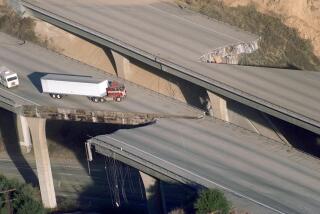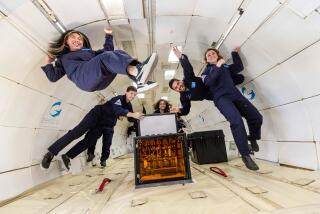Berkeley Loses to Buffalo in Bid for Quake Studies Center
New York has defeated California in a bid for a $50-million national center for earthquake research, it was revealed Saturday.
A committee of the National Science Foundation selected the State University of New York at Buffalo for the center over the University of California, Berkeley.
Buffalo and Berkeley were the two finalists mainly because they have the only two state-of-the-art earthquake simulators in the United States, officials said.
One reason Buffalo was chosen ahead of a California university is because the East is not as well prepared for a major earthquake as the West, they said.
California Gov. George Deukmejian had approved an appropriation of $3 million for a center headquartered at Berkeley. And USC had pledged $2.4 million to a project at Berkeley.
The National Science Foundation will contribute an initial $25 million five-year grant to establish the National Earthquake Engineering Research Center, SUNY Buffalo President Steven B. Sample announced Saturday. New York State will match that amount.
Sample praised Gov. Mario Cuomo and New York’s congressional delegation for pushing for the grant and the center for Buffalo.
“The . . . foundation said this would make the University of Buffalo a worldwide influence in the field of earthquake research and seismographic study,” said Rep. Jack F. Kemp (R-N.Y.).
California officials had argued that California is already the national center for seismic research. The state, they said, has also been a leader in earthquake safety.
Benefit to Country Seen
Some scientists who had expected Berkeley to win the grant said they believe it went to Buffalo because the foundation has poured so much research money into California in the past.
“Earthquake research in general will benefit the country,” said Dr. Bruce Presgrave, a geophysicist with the U.S. Geologic Survey’s National Earthquake Information Center in Golden, Colo.
“In particular, I think there’s a need for a study of structural response and hazards outside the more popular seismic zones in California. It’s good to be emphasizing other parts of the country.”
The center will concentrate on how to limit quake damage and help set design codes. It will be headed by Robert L. Ketter, the university’s president from 1970-82.
“Research . . . will focus on earthquake hazard mitigation, including the protection of structures and lifelines in this country and abroad,” said Ketter, who is also an engineering professor.
“The eastern states are at risk from earthquakes. With the establishment of the center, we will be able to investigate ways to minimize these risks not only here, but throughout the United States.”
Buffalo will serve as the hub of work by a consortium of major university researchers, including those from Rensselaer Polytechnic Institute, Columbia University, Cornell University, Lehigh University and Princeton University.
For instance, planned computer research into ground motion will put data from the Lamont-Doherty Geological Observatory in Palisades, N.J., through Cornell University’s super computers.
SUNY Buffalo, with 26,000 students, is the biggest in the state’s public university system, which is the nation’s largest. Founded as a medical college in 1846, the University of Buffalo was incorporated into the SUNY system in 1962.
The National Science Foundation sponsors research centers in many fields, but this is the first established for earthquake research, officials said.
More to Read
Sign up for Essential California
The most important California stories and recommendations in your inbox every morning.
You may occasionally receive promotional content from the Los Angeles Times.










